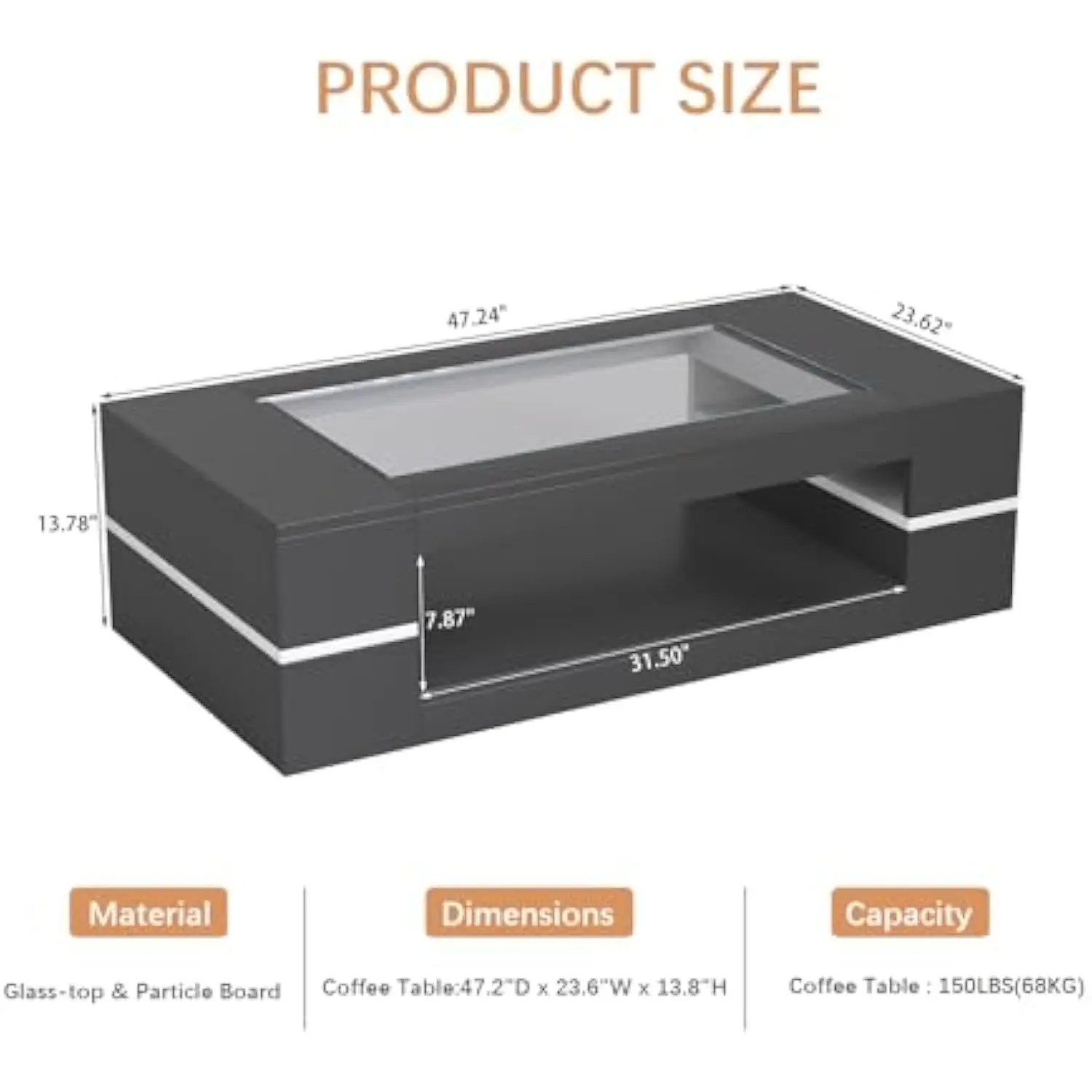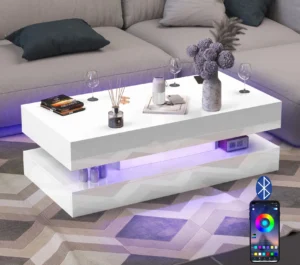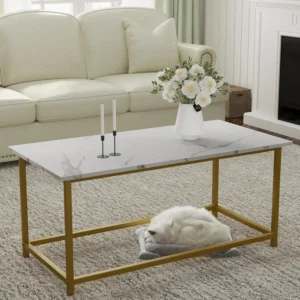The Allure of Large Mid-Century Coffee Tables: Form Meets Function
The perfect large coffee table acts as both an anchor and a statement in a mid-century inspired living space. More than just a functional surface, it becomes the gravitational center around which conversation, relaxation, and daily life revolve. In mid-century design, these substantial pieces represent the perfect marriage of beauty and utility—a core philosophy that makes this style enduringly popular.
When we talk about “large” coffee tables in the context of mid-century design, we’re typically referring to pieces measuring 48-60 inches (122-152 cm) in length and 24-36 inches (61-91 cm) in width. These generous proportions create an unmistakable presence that commands attention while serving practical needs.
Key characteristics of authentic mid-century coffee table design include:
- Clean, uninterrupted lines paired with organic or geometric shapes
- Emphasis on natural materials that showcase craftsmanship
- Functional minimalism that eliminates unnecessary ornamentation
- Artistic expression within practical constraints
The spacious, flowing floor plans common in mid-century architecture practically demanded these larger tables. Unlike earlier design periods that favored smaller, delicate pieces, mid-century designers embraced substantial furniture that could hold its own in more expansive rooms while maintaining visual lightness through clever design.
Mid-century designers like Noguchi and Eames understood that large mid-century coffee tables weren’t just functional—they were artistic focal points that anchored entire living spaces. Their generous proportions provide ample surface area for books, beverages, and decorative elements while establishing a strong visual foundation for the room.
The enduring appeal of these pieces lies in how they balance design advantages of large mid-century coffee tables with practical functionality. Today’s homeowners find that browsing mid-century modern large coffee tables offers the perfect way to infuse authentic period character into contemporary spaces.
Finding the Perfect Size: Proportions and Measurements
Getting the size right is crucial for both the visual impact and functionality of your coffee table. An undersized table will look insignificant and impractical, while one that’s too large can overwhelm the space and impede movement. Understanding proper proportions helps you make a confident choice.
The “Two-Thirds Rule” provides an excellent starting point: your coffee table’s length should be approximately two-thirds the length of your sofa. For example, if you have an 84-inch sofa, aim for a coffee table around 56 inches long. This creates a balanced relationship between the pieces without overwhelming or underwhelming the space.
Height considerations are equally important. Your coffee table should typically be the same height or 1-2 inches lower than your sofa seat—usually falling between 16-18 inches (40-45 cm) from the floor. This height ensures comfortable use whether you’re reaching for a drink or propping up your feet.
Proper clearance around your coffee table is essential for comfortable navigation and use:
* Allow minimum 18 inches (45 cm) between table and surrounding furniture
* Maintain at least 24 inches (60 cm) for walkways around the table
* For sectionals, ensure adequate space on all accessible sides
Different seating arrangements require specific considerations when finding coffee tables for large sectionals versus traditional sofa arrangements. For L-shaped sectionals, rectangular or square tables often work best, while round tables pair beautifully with curved sectionals or conversation areas.
Before making your purchase, try visualizing the table in your space using painter’s tape to outline the dimensions on your floor. This simple step can save you from an expensive mistake by confirming whether your ideal square coffee table dimensions or rectangular choices will truly fit your space.
| Sofa Length | Recommended Coffee Table Length | Ideal Height | Minimum Clearance |
|---|---|---|---|
| 72” (183 cm) | 48” (122 cm) | 16-18” (40-45 cm) | 18” (45 cm) |
| 84” (213 cm) | 56” (142 cm) | 16-18” (40-45 cm) | 18” (45 cm) |
| 96” (244 cm) | 64” (163 cm) | 16-18” (40-45 cm) | 18” (45 cm) |
Essential Materials in Mid-Century Coffee Table Design
A. Timeless Woods
Natural woods form the foundation of mid-century coffee table design, bringing warmth, character, and connection to nature. The choice of wood dramatically influences both the table’s appearance and its durability.
Teak stands as perhaps the quintessential mid-century material, prized for its honey-golden color, natural oils, and remarkable water resistance. Its ability to age beautifully—developing a distinguished silver patina over time—makes solid wood mid-century coffee tables crafted from teak particularly valuable.
Walnut delivers rich, deep tones and distinctive grain patterns that create natural artwork within the furniture itself. Its structural stability makes it ideal for larger tables where warping would be particularly problematic. The chocolate brown color of walnut provides sophisticated contrast in lighter rooms.
Oak offers exceptional strength and a prominent grain texture that adds visual interest. While less common than teak or walnut in original mid-century pieces, oak has become increasingly popular in contemporary interpretations thanks to its durability and versatility.
Today’s consumers should consider sustainability when selecting wooden tables. Look for FSC-certified woods or reclaimed materials that honor the mid-century connection to nature while addressing modern environmental concerns.
B. Glass Elements
Glass tops became iconic in mid-century design for their ability to create visual lightness despite substantial size. This transparency allows other design elements—particularly distinctive table bases—to remain visible, creating a sense of openness.
When selecting glass top mid-century coffee tables, consider the various treatments available:
* Clear glass maximizes light and creates an airy feel
* Smoked glass adds sophistication and subtle color
* Colored glass introduces dramatic accent hues
For larger tables, thickness becomes crucial—typically 3/8 to 1/2 inch (10-12mm) provides necessary strength. Always choose tempered glass for safety, particularly important in family homes. Understanding proper glass coffee table safety tips ensures your statement piece remains both beautiful and practical.
C. Metal Accents and Structures
Metals play a crucial role in mid-century coffee table design, often creating the visual trick of substantial surfaces that appear to float effortlessly. This juxtaposition of weight and lightness is a defining characteristic of the style.
Brass accents add warmth and develop a beautiful patina over time that tells the story of your home. Often used for legs, edging, or inlays, brass provides elegant contrast to wood or glass elements.
Chrome and stainless steel deliver sleek, reflective qualities that epitomize mid-century modernism’s forward-looking optimism. Their durability makes them practical choices for structural elements like legs and frames.
The distinctive leg designs of mid-century tables deserve special attention:
* Tapered legs that narrow toward the floor
* Splayed legs that angle outward for stability and style
* Hairpin legs that create maximum visual lightness
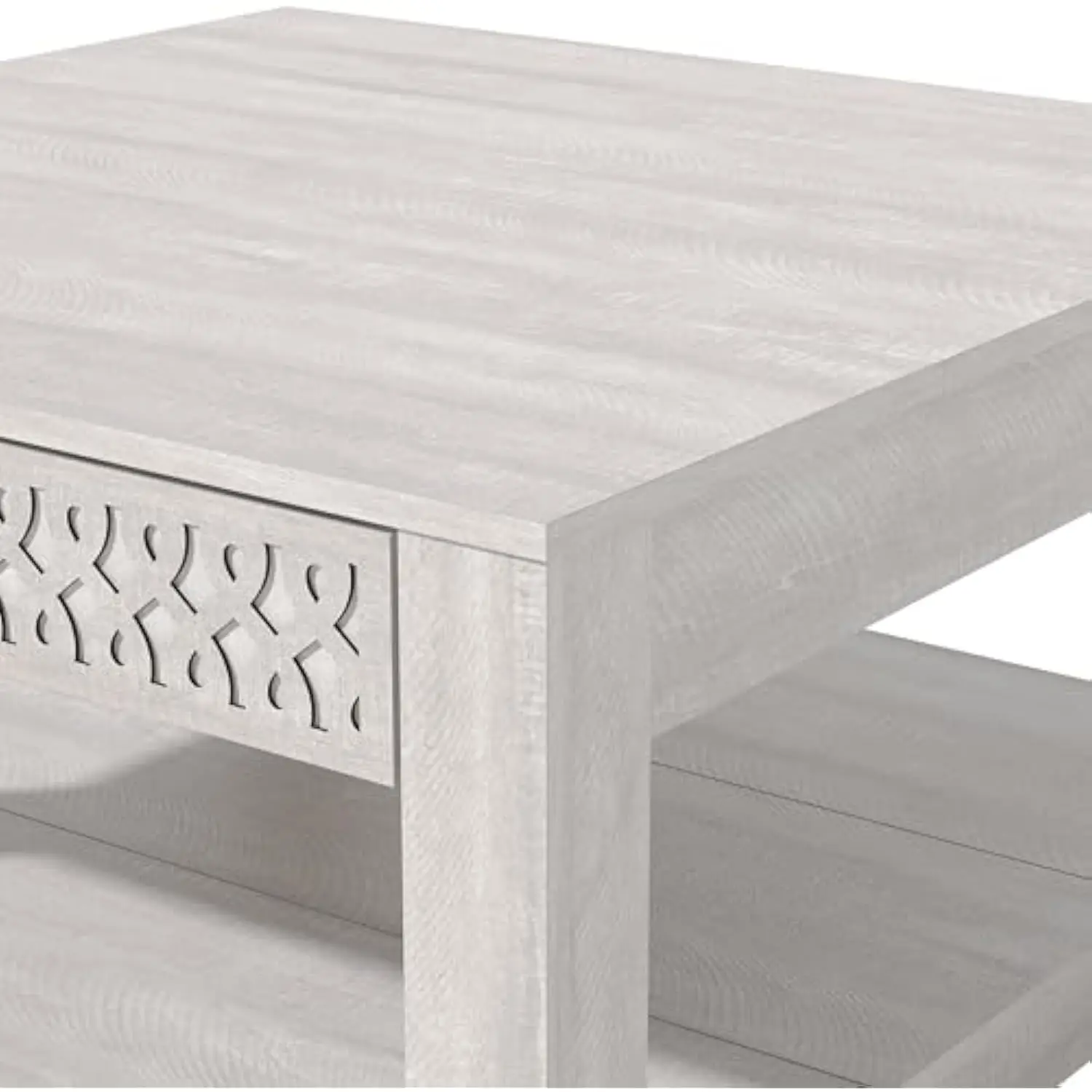
D. Complementary Materials
Stone elements like marble and travertine add sophisticated natural patterning and substantial weight to coffee table designs. Often used for tops or bases, these materials introduce elegant color variations and texture.
Laminates, while sometimes overlooked, played an important role in certain vintage aesthetics, offering bold colors and patterns that were distinctly mid-century. Today’s high-quality laminates can provide durability while honoring this aspect of the style’s history.
Plywood’s ability to be molded into organic curves made it instrumental in creating some of mid-century design’s most iconic shapes. Modern manufacturing techniques have elevated this humble material to new heights of beauty and durability.
Mid-Century Modern Solid Wood Coffee Tables, Mid-Century Modern Teak Coffee Tables
$879.95 Select options This product has multiple variants. The options may be chosen on the product pageMid-Century Modern Danish Coffee Tables, Mid-Century Modern Oval Coffee Tables, Mid-Century Modern Solid Wood Coffee Tables
$390.05 Select options This product has multiple variants. The options may be chosen on the product pageMid-Century Modern Glass Top Coffee Tables, Mid-Century Modern Glass Top Side & End Tables
$460.58 Select options This product has multiple variants. The options may be chosen on the product pageMid-Century Modern Glass Top Coffee Tables, Mid-Century Modern Vintage Coffee Tables, Mid-Century Modern Vintage Side & End Tables
$725.36 Select options This product has multiple variants. The options may be chosen on the product pageMid-Century Modern Large Coffee Tables, Mid-Century Modern Rectangular Coffee Tables
$603.26 Select options This product has multiple variants. The options may be chosen on the product pageMid-Century Modern Marble Top Coffee Tables, Mid-Century Modern Rectangular Coffee Tables, Mid-Century Modern White Coffee Tables
Price range: $163.28 through $189.22 Select options This product has multiple variants. The options may be chosen on the product page
Defining Shapes: Finding the Right Silhouette
A. Rectangular Tables
Rectangular shapes dominated mid-century coffee table design for good reason—they offer versatility and generous surface area while complementing the clean lines of sofas and seating arrangements. When selecting a rectangular table, consider proportions carefully; the most pleasing typically feature a length-to-width ratio of 2:1 or 1.5:1.
These elongated tables excel alongside traditional sofa arrangements, providing easy access from multiple seating positions. Their linear form creates natural flow in a room while offering ample space for books, beverages, and decorative elements.
For maximum impact, position rectangular tables parallel to your largest sofa, creating a balanced relationship between the pieces. This arrangement naturally defines the conversation area while maintaining visual harmony.
B. Square Tables
Square coffee tables make bold statements while creating perfectly balanced focal points in your living space. To qualify as “large” in mid-century terms, square tables typically measure at least 40×40 inches (100×100 cm), creating substantial presence.
These symmetrical pieces work exceptionally well with sectional arrangements or conversation pits, offering equal access from multiple sides. Their geometric simplicity honors mid-century design principles while providing practical functionality.
The visual weight of large square tables demands thoughtful placement. Ensure adequate clearance on all sides, and consider pairing with rounded or curved seating elements to soften the overall effect of the space.
C. Round and Oval Tables
Compared to their angular counterparts, large rectangular and round mid-century tables offer distinctly different benefits. Round tables introduce a softening effect in angular spaces while naturally facilitating conversation and interaction—no corners means easier navigation and more inclusive seating arrangements.
For a round table to make the appropriate statement in a mid-century inspired space, look for diameters of at least 42 inches (107 cm). This generous size ensures the table doesn’t appear diminutive compared to surrounding furniture.
The base design becomes particularly important with round tables, as it’s more fully visible. Consider whether a pedestal base (creating a sculptural statement) or a leg-based design (offering visual lightness) better suits your space and existing furniture.
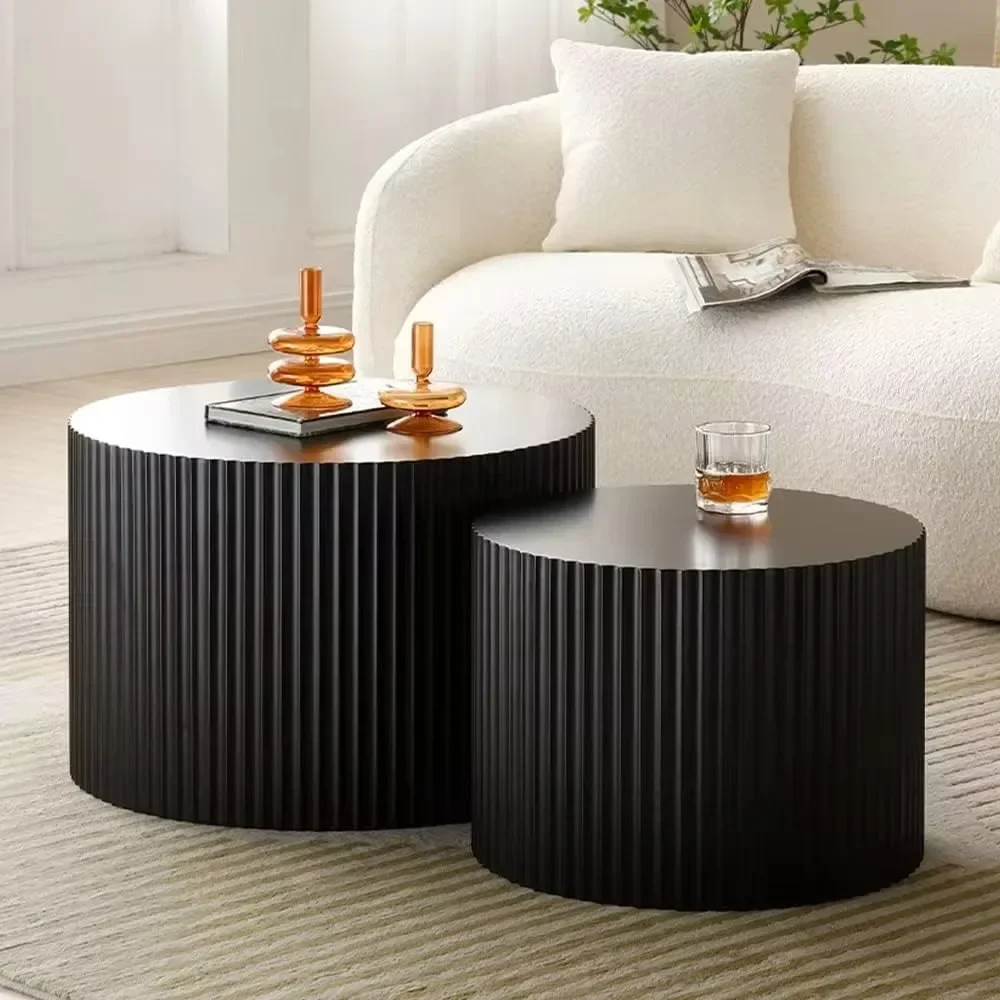
D. Organic and Free-Form Shapes
Perhaps the most distinctively mid-century options are biomorphic or free-form tables that reflect the era’s fascination with organic shapes inspired by nature. These pieces become functional art objects, creating visual interest through unexpected contours.
When incorporating these statement shapes, balance becomes crucial. The distinctive silhouette should have room to breathe—allow adequate space around the piece rather than crowding it with other bold elements that compete for attention.
Despite their artistic nature, these tables must still fulfill practical functions. Look for designs that maintain usable flat surfaces while expressing creative form. The best examples combine sculptural beauty with everyday functionality.
Showcase: Standout Large Coffee Table Designs for Mid-Century Spaces
A. The Expansive Rectangle
Wood-dominant rectangular designs represent perhaps the most classic expression of mid-century coffee table design. Look for pieces featuring solid walnut or teak tops with elegantly tapered legs that create a sense of lightness despite substantial size. The clean lines and warm wood tones of these tables complement virtually any mid-century inspired interior.
Glass-top variations with wooden or metal frames offer an alternative that maximizes visual space—particularly valuable in smaller rooms that still want a large table presence. These designs typically feature distinctive bases that become more prominent thanks to the transparent top.
Storage-inclusive rectangular options provide practical functionality while maintaining clean lines—a perfect embodiment of mid-century design philosophy. Look for pieces with subtle drawers or shelving that don’t interrupt the table’s overall silhouette.
B. Statement Squares and Rounds
Oversized square designs anchor living spaces with confident geometry. The most striking examples incorporate lower shelving that maintains visual lightness while adding storage functionality. Materials like rich walnut or teak create warm, inviting surfaces that invite both use and admiration.
Large diameter round tables with distinctive bases make particularly strong statements in mid-century spaces. Look for pedestal designs that create sculptural interest or tripod legs that exemplify mid-century engineering and aesthetics. The absence of corners makes these pieces particularly well-suited to homes with children or high-traffic areas.
Material combinations enhance visual interest in both square and round tables. Consider designs that thoughtfully pair wood with glass, metal with stone, or contrasting wood species that create natural artwork through their juxtaposition.
C. Sculptural Statements
Organic shapes inspired by natural forms represent some of mid-century design’s most collectible pieces. These biomorphic tables—featuring fluid, asymmetrical outlines—transform living spaces with their artistic presence. Despite their expressive forms, the best examples maintain highly functional surfaces.
Asymmetrical designs create visual flow through rooms while challenging conventional furniture arrangements. Their unexpected shapes draw the eye and invite conversation, making them perfect centerpieces for social spaces.
The thoughtful integration of multiple materials adds further distinction to sculptural pieces. Look for features of large mid-century modern tables that combine wood species with different colorations or pair organic materials with industrial elements for compelling contrast.
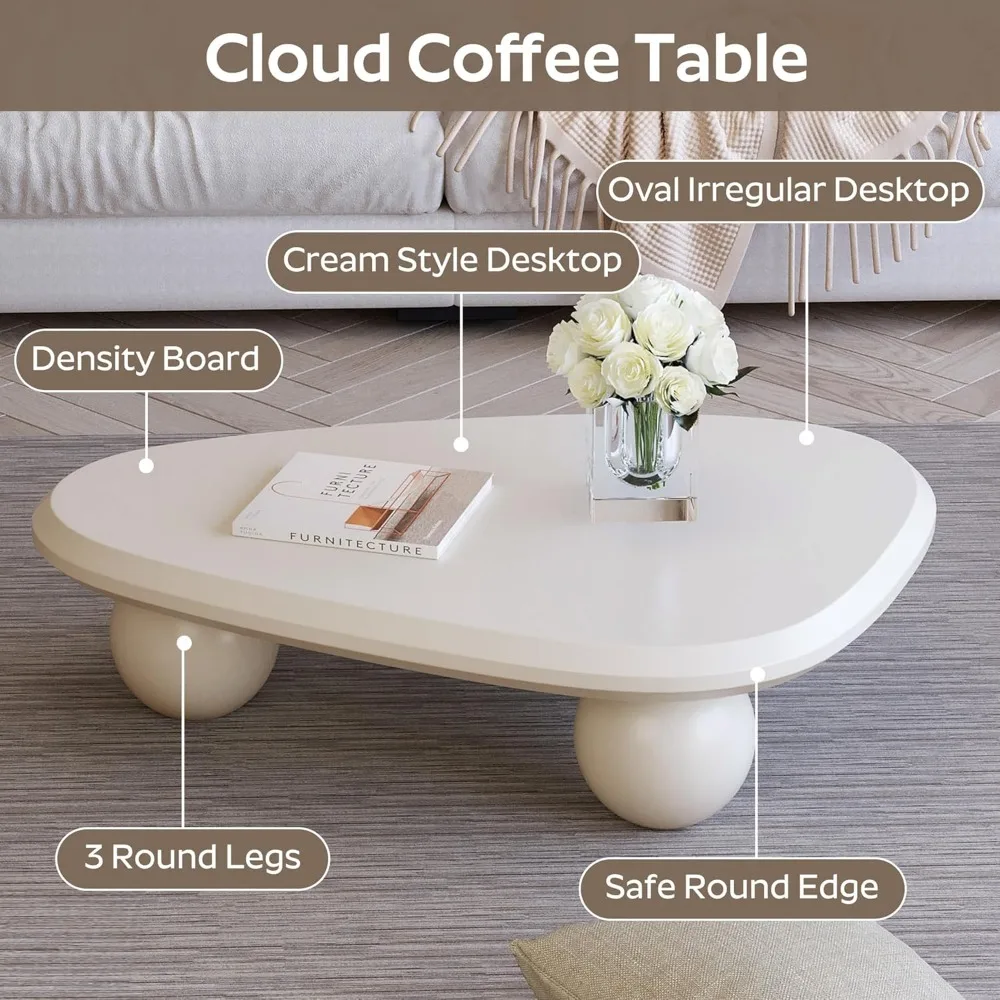
D. Multi-Level Masterpieces
Tiered designs offering varied surface heights epitomize mid-century innovation. These pieces provide practical functionality—allowing different activities on different levels—while creating visual interest through dimensional complexity. Their ability to separate objects by height creates natural organization.
Nesting capabilities add remarkable versatility to some mid-century inspired tables. These ingenious designs conceal smaller tables beneath larger ones, allowing you to expand your surface area when entertaining or minimize it for everyday use.
Despite their substantial size and multi-level construction, these tables often achieve visual lightness through thoughtful design. Look for white mid-century modern coffee tables with cantilevers, strategic voids, or tapered elements that create the impression of floating components.
Styling Your Statement Piece: The Art of Balance
Mid-century design embraced the philosophy that “less is more”—a principle particularly important when styling large coffee tables. Rather than cluttering the surface with numerous small objects, select fewer, more significant pieces that create intentional composition.
Creating balanced vignettes enhances your table without overwhelming it:
* Group objects in odd numbers (three or five items typically work well)
* Vary heights and silhouettes for visual interest
* Incorporate negative space around objects
* Consider the view from all seating positions
Choose accessories that honor mid-century aesthetics while reflecting your personal style:
* Sculptural elements with organic or geometric forms
* Art books with striking graphic covers
* Ceramics in earthy tones or bold period colors
* Plants that introduce natural elements—particularly architectural varieties like succulents
Remember that your coffee table must remain functional despite its decorative elements. Leave open space for practical use and consider creating seasonal styling variations that keep your space fresh while maintaining mid-century principles.
When arranging your room around a large coffee table, consider how people move through the space. The table should anchor the seating area while allowing comfortable navigation. This balance of form and function perfectly captures the essence of versatile appeal in large mid-century coffee tables.
Where to Find Quality Large Mid-Century Coffee Tables
A. New Production and Reproductions
Today’s market offers excellent new productions that honor mid-century design principles while incorporating modern manufacturing techniques. Specialty retailers like Hearth Forms focus specifically on authentic mid-century inspired pieces, ensuring proper proportions and materials.
When evaluating new pieces, look for:
* Solid wood construction (not veneers over particleboard)
* Proper joinery techniques (dovetail or mortise-and-tenon joints)
* Authentic materials appropriate to mid-century design
* Attention to proportions and scale
Custom furniture makers specializing in mid-century aesthetics offer another excellent option, particularly if you have specific size requirements or material preferences. While typically more expensive than mass-produced items, these bespoke pieces ensure perfect fit and finish.
B. Vintage and Authentic Pieces
For purists, nothing compares to authentic vintage mid-century coffee tables. Specialized vintage furniture dealers curate collections of period pieces, often restoring them to excellent condition while preserving their character and patina.
When shopping for vintage items, authentication becomes important:
* Research distinctive design details of various manufacturers
* Examine construction techniques and materials
* Look for maker’s marks or labels when possible
* Ask about provenance and history
Online marketplaces have made vintage hunting more accessible, but require careful evaluation of condition. Request detailed photos of all sides, underneath, and any damaged areas. Factor restoration costs into your budget if necessary.
C. Budget Considerations
Quality large mid-century coffee tables represent genuine investment pieces that typically appreciate in value over time—particularly authentic vintage items or well-crafted new productions using proper materials and techniques.
Different materials and construction methods significantly impact cost:
* Solid wood pieces command higher prices than those using veneers
* Hand-crafted joinery increases both quality and cost
* Rare or exotic woods typically demand premium pricing
* Genuine vintage pieces with documented provenance carry collector value
When considering large mid-century coffee tables for homes, balance quality against budget. A well-made reproduction often provides better value than a poorly-constructed “authentic” piece. Brands like Hearth Forms focus on delivering quality craftsmanship that honors mid-century principles while providing lasting value.
For those seeking authentic vintage character, vintage mid-century modern coffee tables offer distinctive patina and history that new productions cannot replicate.
Care and Maintenance for Longevity
Proper care ensures your investment remains beautiful for generations, preserving both appearance and value. Different materials require specific maintenance approaches:
For wood surfaces:
* Dust regularly with a soft, lint-free cloth
* Apply appropriate wood conditioner quarterly to prevent drying
* Use coasters to prevent water rings and heat damage
* Maintain consistent humidity levels to prevent cracking
* Address spills immediately to prevent staining
For glass elements:
* Clean with appropriate glass cleaner and microfiber cloth
* Avoid abrasive cleaners that can scratch surfaces
* Use felt pads beneath decorative objects to prevent scratches
* Check and tighten any hardware securing glass components
For metal components:
* Dust regularly to prevent buildup in crevices
* Apply appropriate metal polish based on specific material
* Protect brass from excessive moisture to prevent tarnishing
* Address any rust spots immediately on iron components
Seasonal maintenance helps preserve your table’s beauty. Every six months, check all connections and joints, tightening any loose hardware. Reposition occasionally to prevent uneven sun exposure that can cause discoloration.
Protective measures during daily use significantly extend your table’s life:
* Use coasters for all beverages
* Apply felt pads to the bottom of decorative objects
* Consider custom glass tops for valuable wood surfaces in high-use areas
* Use tablecloths or placemats during messy activities
Frequently Asked Questions About Large Mid-Century Coffee Tables
How do I know if a table is genuinely mid-century styled?
Authentic mid-century design typically features clean lines, organic shapes, tapered legs, and natural materials. Look for simple forms without excessive ornamentation, functional minimalism, and proportions that create visual lightness despite size. Authentic materials include solid woods like teak, walnut, and oak, often paired with glass or metal elements.
Can a large coffee table work in a small space?
Yes, with careful consideration. Choose designs with glass tops or open bases that create visual lightness. Consider round shapes that eliminate sharp corners or rectangular pieces with narrower widths. The key is maintaining proper clearance (minimum 18 inches) around all sides while ensuring the table doesn’t overwhelm the room’s proportions.
What’s the most durable material for a heavily used coffee table?
Solid hardwoods like oak and walnut offer excellent durability for family use. Look for tables with quality finishes that resist scratches and moisture. Tempered glass provides surprising resilience when properly supported. For maximum durability, consider designs combining hardwood with metal structural elements.
How can I tell if a reproduction is high quality?
Examine joinery—quality reproductions use traditional techniques like dovetail or mortise-and-tenon joints rather than visible screws or staples. Check material thickness and solid construction. Quality pieces have consistent finishes, smooth drawer operation, and proper proportions matching original mid-century designs. Weight often indicates quality—substantial pieces typically use proper materials throughout.
Are there child-friendly options for large mid-century coffee tables?
Yes—look for rounded corners or fully round/oval tables that eliminate sharp edges. Tables with solid wood construction withstand rough use better than delicate materials. Some designs incorporate storage for toys or games. Consider height carefully—lower tables are more accessible to children while reducing fall hazards.

